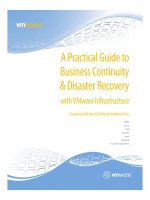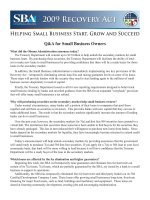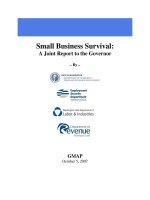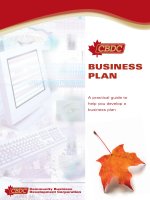John wiley sons beyond 401(k)s for small business owners a practical guide to incentive deferred compensation and retirement plans isbn047127268
Bạn đang xem bản rút gọn của tài liệu. Xem và tải ngay bản đầy đủ của tài liệu tại đây (11.29 MB, 275 trang )
TeAM
YYeP
G
Digitally signed by TeAM
YYePG
DN: cn=TeAM YYePG,
c=US, o=TeAM YYePG,
ou=TeAM YYePG,
email=
Reason: I attest to the
accuracy and integrity of
this document
Date: 2005.04.27
16:31:52 +08'00'
BEYOND
401(k)S
FOR
SMALL
BUSINESS
OWNERS
A Practical Guide to Incentive,
Deferred Compensation,
and Retirement Plans
JEAN D. SIFLEET
John Wiley & Sons, Inc.
BEYOND
401(k)S
FOR
SMALL
BUSINESS
OWNERS
BEYOND
401(k)S
FOR
SMALL
BUSINESS
OWNERS
A Practical Guide to Incentive,
Deferred Compensation,
and Retirement Plans
JEAN D. SIFLEET
John Wiley & Sons, Inc.
Copyright © 2004 by Jean D. Sifleet, Esq. All rights reserved.
Published by John Wiley & Sons, Inc., Hoboken, New Jersey.
Published simultaneously in Canada.
No part of this publication may be reproduced, stored in a retrieval system, or
transmitted in any form or by any means, electronic, mechanical, photocopying,
recording, scanning, or otherwise, except as permitted under Section 107 or 108 of
the 1976 United States Copyright Act, without either the prior written permission of
the Publisher, or authorization through payment of the appropriate per-copy fee to
the Copyright Clearance Center, Inc., 222 Rosewood Drive, Danvers, MA 01923,
(978) 750-8400, fax (978) 750-4470, or on the web at www.copyright.com. Requests
to the Publisher for permission should be addressed to the Permissions Department,
John Wiley & Sons, Inc., 111 River Street, Hoboken, NJ 07030, (201) 748-6011, fax
(201) 748-6008, e-mail:
Limit of Liability/Disclaimer of Warranty: While the publisher and author have used
their best efforts in preparing this book, they make no representations or warranties
with respect to the accuracy or completeness of the contents of this book and
specifically disclaim any implied warranties of merchantability or fitness for a
particular purpose. No warranty may be created or extended by sales representatives
or written sales materials. The advice and strategies contained herein may not be
suitable for your situation. The publisher is not engaged in rendering professional
services, and you should consult a professional where appropriate. Neither the
publisher nor author shall be liable for any loss of profit or any other commercial
damages, including but not limited to special, incidental, consequential, or other
damages.
For general information on our other products and services please contact our
Customer Care Department within the United States at (800) 762-2974, outside the
United States at (317) 572-3993 or fax (317) 572-4002.
Wiley also publishes its books in a variety of electronic formats. Some content that
appears in print may not be available in electronic books. For more information
about Wiley products, visit our web site at www.wiley.com.
Library of Congress Cataloging-in-Publication Data:
Sifleet, Jean D., 1948–
Beyond 401(k)s for small business owners : a practical guide to incentive,
deferred compensation, and retirement plans / Jean D. Sifleet.
p. cm.
Includes index.
ISBN 0-471-27268-X (pbk.)
1. Employee fringe benefits. 2. Small business—Management. 3. Pensions.
4. Incentive awards. I. Title.
HD4928.N6S57
658.3′22—dc21
2003
2003041101
Printed in the United States of America.
10 9 8 7 6 5 4 3 2 1
This book is dedicated with great respect to small
business owners who overcome incredible obstacles
and create prosperity for themselves, their families,
and employees.
PREFACE
The goal of this book is to provide information, in clear ordinary language, that enables small business owners to move
ahead with confidence and take advantage of many tools to
enhance compensation and retirement benefits.
In preparing this book, I owe thanks to many people. My
family and friends endured many months of my questions and
requests for feedback. Special thanks are owed to my contributing experts who generously shared their knowledge and
experience so that this book would tell you candidly how to
avoid pitfalls.
Extra special thanks go to Michael Hamilton and the full extended team from John Wiley & Sons, without whose commitment this book would not have happened.
vii
CONTENTS
1. What Are You Trying to Accomplish?
Different Goals Need Different Plans
Compensation and Benefits Evolve as the
Business Grows
“Be Careful What You Ask For”
For a Current Tax Deduction, You Need a
“Qualified Plan”
To Limit Participitation in the Plan, You Need a
“Nonqualified Plan”
Look at the Big Picture before Diving into
the Specifics
The Bewildering Array of Alternatives
2. Why Have a Compensation Plan?
Compensation Reflects Your Company’s Values
Base Pay and Benefits
What Do You Currently Offer?
How Does Your Pay Compare?
Use Compensation to Motivate Employees
What Behaviors Do You Want to Encourage? Discourage?
Writing Your Compensation Plan
A Written Plan Will Help You Be Consistent
Using a Calendar Time Line
Next, Create a Visual Calendar Framework for
Your Planning Process
What Is Important to Employees?
Planning Is an Ongoing Process
ix
1
2
2
4
4
5
6
6
13
13
14
15
16
16
16
17
19
19
21
21
22
x
Contents
3. What Is Important to Employees?
Employee Input Is Critical
Research Shows Some Reasons for Employee
Dissatisfaction
Research Shows What Employees Typically Want
Improving Noncompensation Issues
Improving Compensation Issues
Has Your Company Done the Following?
Improving Benefits
How to Assess What Your Employees Really Want
Benefit Survey Dos and Don’ts
Conclusions
4. What Is the Current Employee Picture?
Getting an Integrated Picture of the Workforce
Informed Decision Making
Conclusion
5. Family Business?
Recurring Patterns of Family Dynamics
Succession Planning 1-2-3
Special Considerations in Evaluating Options
for a Family Business
6. What Are the Options?
Part 1—Easy and Inexpensive Options
Part 2—More Complicated and Costly Plans
Part 3—Complex and Expensive Plans
Tax Consequences—Incentive Stock Options
Tax Consequences—Nonqualified Stock Options
25
25
26
27
27
29
29
30
31
31
34
35
35
36
37
39
39
40
44
47
47
55
68
74
76
7. What Do You Really Need to Know about
Buying Life Insurance?
87
Why Buy Life Insurance?
Overview of the Life Insurance Buying Process
What to Do If You Are in Poor Health
Tax Issues
87
90
97
98
Contents
Tips for Getting the Best Terms
Best Buys in Life Insurance
Conclusion
8. Case Studies That Illustrate Alternatives
Phase 1. Start-Ups and the Early Years
Phase 2. Continuing to Grow
Phase 3. Becoming More Profitable
Phase 4. Success! And Your Retirement Approaches
Cross-Tested Profit-Sharing 401A(4)
Defined Benefit Plans
Contributions: Comparing Apples with Apples
Nonqualified Plans
Conclusion
9. Requesting Proposals
10. Implementing Your Plan
Phase 1. Introducing the Plan to Employees
Phase 2. Staying in Compliance with the Law
Conclusion
xi
99
102
105
107
108
110
112
118
119
121
126
126
131
133
137
137
138
145
11. Tips from Experts to Avoid Common Mistakes
in Retirement Plans
147
12. Financial Health-Check: Is Your Plan on
Track to Achieve Your Goals?
167
Is Current Funding Adequate for Retirement Needs?
Funding the Shortfall
Get a Second Opinion
Schedule a Financial Health-Check
13. Avoiding Chaos: Estate Planning and
Retirement Planning
Severe Consequences of Doing Nothing
Conclusion
168
169
176
176
179
180
183
xii
Contents
14. Resources and References
Internal Revenue Service
Department of Labor (DOL) Employee Benefits and
Security Administration (EBSA)
Appendix
Index
Common Definitions
185
186
186
249
253
BEYOND
401(k)S
FOR
SMALL
BUSINESS
OWNERS
1
WHAT ARE
YOU TRYING
TO ACCOMPLISH?
Running a business can be so all-consuming that it is easy to
lose sight of long-term goals. It is important to take time out
to regain perspective on what you are trying to accomplish:
• Attract and retain key employees?
• Reduce taxes?
• Plan for retirement income?
Employees are a key challenge for small business owners.
The success of the business depends on attracting and retaining high-performing employees. Top performers want more
than basic salary, benefits, and vacation days. Motivating key
employees requires recognition and rewards. If used effectively, incentive compensation can be a powerful tool to reward excellent performance.
Reducing taxes is always attractive to business owners, as is
planning for retirement. After achieving profitability, smart
business owners start to think about deferring current income
and putting money into retirement plans. The tax advantages
1
2
What Are You Trying to Accomplish?
are clear: You can reduce current tax liability, both personally
and for the business, while allowing invested assets to grow taxdeferred. Although many business owners and their employees
are concerned about deferring current income and planning for
their retirement, the reality is that a plan is seldom in place.
Many of the 26 million small businesses in the United States,
which employ 51 percent of this nation’s workers, have a compelling need for retirement planning.
DIFFERENT GOALS NEED DIFFERENT PLANS
Since personal and business goals should drive the planning
process, this chapter includes checklists and forms to assist
you in prioritizing goals. As you read, ask yourself, “What is
really important to me down the road?”
1. Comfortable retirement?
2. Do not want to pay for employees’ retirement (maximize
owner compensation)?
3. Reduce taxes?
4. Share profits with employees without sharing ownership?
5. Encourage employee ownership?
6. Personal goals
(insert your personal goals)?
COMPENSATION AND BENEFITS EVOLVE
AS THE BUSINESS GROWS
Compensation and benefits often develop on an as needed
basis to fill specific requirements during the development of a
business. Many companies start with basic pay and benefits,
Compensation and Benefits Evolve as the Business Grows
3
Table 1.1 Examples of Benefits
Basic Benefits
Medical and dental insurance
Vacation and holidays
Sick leave and unpaid personal leave
Business expense reimbursement (car, travel)
Additional Benefits
Life and disability insurance
Dependent care and health care reimbursement accounts (also
called Section 125 plans)
and then add other benefits as the business becomes able to afford the expense (see Table 1.1).
Small businesses have to be creative with compensation
since few of them can match the pay and benefits offered by
larger companies (see Table 1.2).
Flexibility and the opportunity to share in future growth are
major attractions for employees of small businesses. Providing
employees with incentive compensation that matches the goals
of the business (and business owner) is critical.
Table 1.2 Creative Compensation Incentives
On-site gym/fitness center, basketball
Day care
Ice cream/pizza days
Bringing child to work
Coffee
Bringing dog to work
Car, travel
Company outings
Flexible hours, work from home
Free turkey at Thanksgiving
4
What Are You Trying to Accomplish?
“BE CAREFUL WHAT YOU ASK FOR”
There is an old saying: “Be careful what you ask for—because
you may get it.” Employees respond to incentives, so it is important to align your incentives with the company goals. If the
two do not match, you will not get the desired results. Poorly
designed incentive compensation can backfire and be counterproductive, whereas rewarding excellent performance with
well-designed incentive compensation can create a prosperous business environment (see Table 1.3).
FOR A CURRENT TAX DEDUCTION,
YOU NEED A “QUALIFIED PLAN”
To get a tax deduction for contributing funds to a “qualified
plan,” you must comply with strict rules for including employees and limiting contributions. Examples of qualified plans include 401(k), SEP (Simplified Employee Pensions), SIMPLE
(Savings Incentive Match Plans for Employees), and ESOP (Employee Stock Ownership Plans). In addition, there are investment options and differences between defined-benefit (DB) and
defined-contribution (DC) plans (see Table 1.4).
Table 1.3 Incentive and
Deferred Compensation Plans
Commission and bonus plans
Profit sharing
Stock options (qualified and nonqualified)
To Limit Participation, You Need a “Nonqualified Plan”
5
Table 1.4 Qualified Plans (Current Tax Deduction)
401(k) program
Simplified Employee Pension (SEP)
Savings Incentive Match Programs for Employees (SIMPLE)
Defined benefit (DB)
Defined contribution (DC)
Employee Stock Ownership Plan (ESOP)
TO LIMIT PARTICIPATION IN THE PLAN,
YOU NEED A “NONQUALIFIED PLAN”
Nonqualified plans allow you to limit the participants in the
plan. This means that you can exclude some employees and
only include the principals or selected members of your team.
Although you will not get a current tax deduction for your
contributions, you can achieve aggressive financial benefits
with nonqualified plans.
With these plans, there is no tax deduction until the employee begins receiving benefits (usually at retirement). When
the employee begins reporting income, the employer can deduct
the payment. Examples of nonqualified plans include Supplemental Executive Retirement Plans (SERP), excess benefit plans,
and split dollar plans (see Table 1.5).
Nonqualified plans that enhance retirement benefits can be
powerful tools to attract and retain key employees. “Forfeiture” provisions (also called “golden handcuffs”) encourage
employees to stay with their present employer instead of leaving to work for a competitor.
6
What Are You Trying to Accomplish?
Table 1.5 Nonqualified Plans
(No Current Tax Deduction)
Supplemental Executive Retirement Plans (SERP)
Excess benefit plans
Split dollar plans
LOOK AT THE BIG PICTURE BEFORE
DIVING INTO THE SPECIFICS
It is important to step back and reassess what you are trying to
accomplish before focusing on specifics. Incentives, deferred
compensation, and retirement planning are components of the
overall compensation plan for the company. Since compensation drives business performance, you need to align your compensation strategies with your business goals.
THE BEWILDERING ARRAY OF ALTERNATIVES
Evaluating the alternatives can be overwhelming for small
business owners who focus primarily on running the business.
Examining the options can be like getting lost in the “trees”
(details and issues) and losing sight of the “forest” (the business goals). Large corporations hire compensation experts to
perform analyses, design models, and create complex, multifaceted compensation programs. Most small business owners,
however, have neither the time nor personnel for such elaborate processes.
In choosing a plan for your business, cost and complexity of
administration are major factors. So it makes sense to focus on
that perspective when looking at your options. As we discuss
The Bewildering Array of Alternatives
7
Table 1.6 Options Framework by Complexity and
Cost of Administration
Easy/Inexpensive
More Complicated/Costly
Complex/Expensive
Bonus
SEP
SIMPLE
Defined contribution
401(k)
Defined benefit
Stock options
Nonqualified plans
ESOP
the alternatives, we will view them from the perspective of
easy and inexpensive to administer, to more complicated and
costly, to complex and expensive. This framework will help
you evaluate the pros and cons and make a choice that is a
good fit for your business (see Table 1.6).
If you already have a plan in place, changing is tricky. You
must carefully plan any changes and clearly communicate them
to motivate employee performance and achieve business results. Changes are disruptive and raise concerns with employees. To ensure a positive outcome, think about compensation in
a comprehensive manner. Do not just add a 401(k) plan without
looking at the overall picture.
So, step back and reassess what you are trying to accomplish
before tackling the specifics of the options. Filling out Worksheet 1.1 will pinpoint your long-term objectives and enable
you to make informed choices about the options available.
Different situations require different plans. Writing down
this information will make it easier to pull together a request
for proposals later. It will also help you avoid the following
common mistakes.
8
What Are You Trying to Accomplish?
W ORKSHEET 1.1
Company Background Information Worksheet
Name of Company
Address of Company
Employer Identification Number (EIN)
Organization Form
S-Corp
C-Corp
LLC
Unincorporated
Year Founded
Type of Product or Service
Names of Owners
Percentage of Ownership
Number of Employees
Family Members Work
in the Business
Employee Ages
Employee
Salary Range
Age
(See also the Employee Data Table Worksheet 4.1 on p. 36.)
Affiliated Companies
(Is there common ownership of any other companies?)
How is the business doing?
Stable or increasing revenues?
Can you make a fixed annual commitment to fund a plan?
Do you need to determine plan contribution annually?









